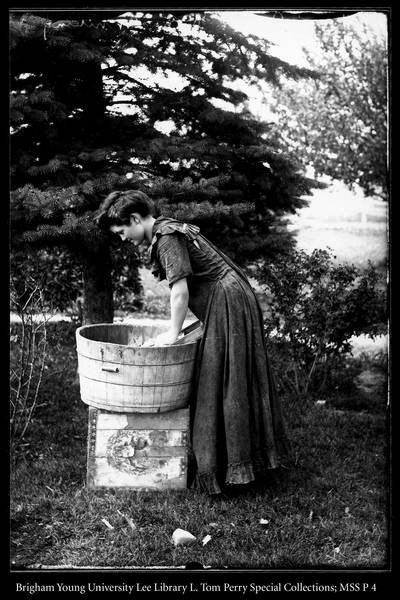Dublin Core
Title
Description
In the 1900s, before the luxuries of rural electricity and indoor plumbing, washing clothes was a physical and time-intensive chore for many Utahns. Generally, people owned fewer clothes, so wash day occurred only once per week. Wealthy families could avoid this work by paying for their wash to be done out of the house, but for most households laundry required the entire family to work together.
At the Munson family home in Escalante, wash day began early with gathering firewood. Older boys would chop while younger ones gathered tree limbs for the outdoor fire. Children filled the wash bins from a nearby well and placed them over the fire. The hard water needed to be softened so that the soap would lather up. To do this, women boiled the water and sprinkled lye into it. This caused a hard scum to rise to the top. Once this was scraped off, the water was ready to use.
Fortunately for the Munsons, they had a gasoline-powered washing machine to help with the wash. Soap made from animal fats and lye sat in thick chunks ready to grate into the first tub of prepared water. The second tub was for white clothes and linens, which were boiled to loosen the dirt and help keep them white. The soapy water was then poured into the machine and a foot pedal or crank was used to start the motor that agitated the clothes. Although the Munsons remember the washer being unreliable, it was better than scrubbing their dirty clothes against a washboard.
By the 1930s, wash day had changed significantly for families like the Munsons. Indoor plumbing, electricity, and the introduction of electric washing machines eased the burden of laundry day. Water poured from a tap in their homes, which meant they no longer had to walk to a well, or boil and prepare water for washing. Thanks to these changes, the longest trip most Utahns now make for laundry is to mom’s house or the nearest laundromat!
Creator
Source
_______________
See “Clean Clothes Blowing in the Breeze,” The History Blazer, April 1996; Voyle Munson, Munson Memories: History of Lewis Leo and HOrtense Cope Munson Family (Bountiful: The Leo Munson Family Organization, 1993); Douglas D. Alder and Karl F. Brooks, A History of Washington County: From Isolation to Destination (Salt Lake City: Utah State Historical Society and Washington County, 1996): 139-140; John W. Fitzgerald, "Transition - From Sagebrush to Satellite," J. Willard Marriott Library, accessed May 2021; Eleanor P. Madsen, “A Saturday Remembered,” Saga of the Sanpitch 8 (1976): 41-42; Lucille R. Seely, “I Remember When,” Saga of the Sanpitch 9 (1977): 99-100.

